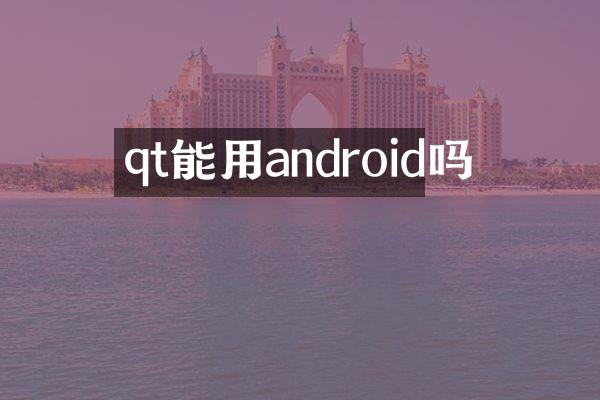Qt is a versatile and powerful framework primarily used for developing cross-platform applications. Originally developed by Trolltech, now owned by The Qt Company, Qt enables developers to create applications that can run on various platforms such as Windows, macOS, Linux, and even mobile platforms like Android and iOS. So, the simple answer to the question "Can Qt be used for Android development?" is yes, but let's delve deeper into why Qt is a suitable choice for Android development and how it facilitates the process.

Introduction to Qt for Android Development:
Qt provides a comprehensive set of tools and libraries for developing applications for Android. It offers a wide range of features and functionalities that make it an excellent choice for Android development. Here are some key points to consider:
1. Cross-platform Development: Qt allows developers to write code once and deploy it on multiple platforms, including Android. This significantly reduces development time and effort, as developers do not need to rewrite the entire application for each platform.
2. Native Look and Feel: Qt ensures that applications built using the framework have a native look and feel on each platform, including Android. This is achieved through Qt's platform abstraction layer, which adapts the user interface components to match the native style guidelines of each platform.
3. Support for Android APIs: Qt provides extensive support for Android APIs, allowing developers to access device-specific features and functionalities such as sensors, camera, location services, and more. This enables developers to create feature-rich and powerful Android applications using Qt.
4. Qt for Android Tooling: Qt offers a range of development tools specifically tailored for Android development. These tools include Qt Creator, Qt Designer, and Qt Quick Designer, which provide an integrated development environment (IDE) for designing, coding, testing, and debugging Android applications.
Key Components of Qt for Android Development:
To develop Android applications using Qt, developers primarily leverage the following key components:
1. Qt Core: Qt Core provides essential non-GUI functionality, such as string handling, file I/O, and networking. It forms the foundation of Qt-based Android applications by offering a robust set of classes and APIs for handling common tasks.
2. Qt GUI: Qt GUI provides classes for creating graphical user interfaces, including widgets and graphics view framework. While Qt GUI is primarily used for desktop applications, Qt Quick, a part of Qt GUI, is more suitable for developing modern, touch-enabled user interfaces for Android applications.
3. Qt Quick: Qt Quick is a powerful framework for developing fluid and dynamic user interfaces using QML (Qt Modeling Language) and JavaScript. It offers a declarative approach to UI design, making it easy to create visually appealing and interactive interfaces for Android applications.
4. Qt Android Extras: Qt Android Extras module provides additional APIs for accessing Android-specific features and functionalities not covered by the core Qt modules. This includes APIs for accessing device sensors, camera, location services, notifications, and more.
Development Workflow with Qt for Android:
Developing Android applications with Qt typically involves the following workflow:
1. Setting up Development Environment: Install Qt SDK and necessary Android development tools (Android SDK, Android NDK) on your development machine.
2. Creating Qt Project: Use Qt Creator to create a new Qt project for Android. Choose the appropriate project template and configure project settings.
3. Designing User Interface: Use Qt Designer or Qt Quick Designer to design the user interface of your Android application. Qt Quick allows you to create fluid and dynamic UIs using QML and JavaScript.
4. Writing Application Logic: Write the application logic and backend code using C++ or JavaScript, depending on your preference. Use Qt Core and other Qt modules to implement functionality.
5. Building and Deploying: Build the application for the Android platform using Qt Creator. Deploy the application to an Android device or emulator for testing and debugging.
6. Testing and Optimization: Test the application on various Android devices and screen sizes to ensure compatibility and responsiveness. Optimize the application for performance and resource usage as needed.
Conclusion:
In conclusion, Qt is a powerful framework for developing Android applications, offering cross-platform compatibility, native look and feel, extensive support for Android APIs, and a range of development tools. By leveraging Qt's capabilities, developers can create high-quality Android applications efficiently and effectively. Whether you're building a simple utility app or a complex mobile solution, Qt provides the tools and resources you need to succeed in Android development.